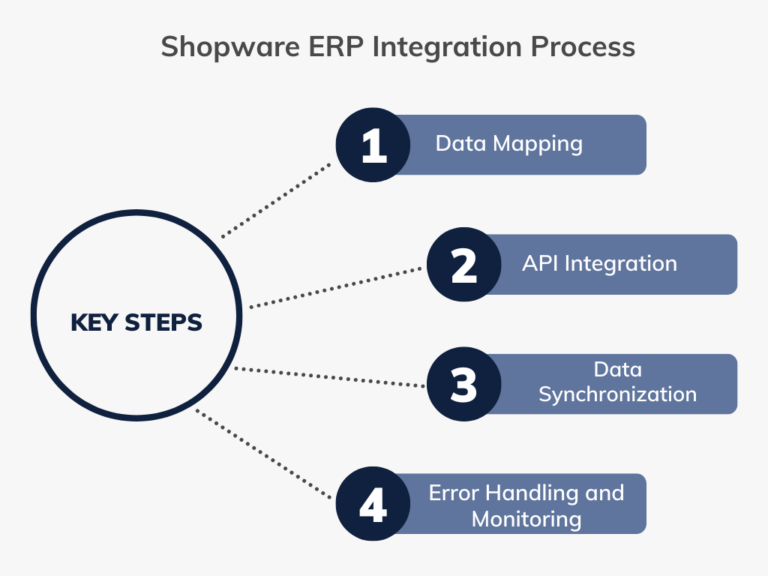Greetings! I'm Aneesh Sreedharan, CEO of 2Hats Logic Solutions. At 2Hats Logic Solutions, we are dedicated to providing technical expertise and resolving your concerns in the world of technology. Our blog page serves as a resource where we share insights and experiences, offering valuable perspectives on your queries.

ERP integration with Shopware is one of the great steps towards increasing business efficiency and improving data accuracy by the business across platforms. While Shopware ERP integration improves business effectiveness, it is also critical to recognize the main mistakes that occur during Shopware ERP integration.
Let’s look at how to avoid these common mistakes.
Benefits of Connecting Shopware with an ERP System
Shopware ERP integration offers substantial benefits for e-commerce businesses:
- Real-Time Data Synchronization: An ERP system allows for immediate updates and eliminates the possibility of errors in maintaining accurate inventory, pricing, and order statuses.
- Enhanced Customer Satisfaction: Businesses with up-to-date order and stock information can track orders on time and give timely customer support.
- Efficient Inventory Management: The ERP system minimizes concerns of overselling or stockout across channels with integrated control.
Steps to Integrate Shopware with an ERP System

The stages for successful Shopware ERP integration are as follows:
Step 1: Choose the ERP that best fits your e-commerce organization and supports Shopware.
Step 2: Correct field mapping to ensure all SKU, stock level, and pricing information is properly mapped.
Step 3: Configure the system and extensively test for points of failure.
Step 4: Synchronization issues should be recognized and resolved frequently.
Struggling with integration issues?
Reach out for a solution today!
Challenges in Shopware ERP integration

Common mistakes to avoid during Shopware ERP integration
When integrating Shopware with your ERP system, you will encounter many important challenges if the ERP does not have native integration capabilities for Shopware. Although most current ERP systems include pre-built connectors for Shopware that can automatically address such concerns, custom ERP integrations require you to pay special attention to avoid repeating typical errors and their solutions:
1. Inadequate Data Mapping and Validation
Mistake: improper mapping of fields between ERP and Shopware, resulting in inconsistent or misaligned data.
Solution: Strong field mapping from both systems and rigorous validation are required. Product numbers, stock levels, prices, and customer data must be thoroughly checked for accurate synchronization.
2. Poor Inventory Syncing Logic
Mistake: Using sync logic that does not consider various sales channels or is inefficient in handling rapid updates.
Solution: Choose an appropriate synchronizing mechanism depending on inventory needs, such as real-time, schedule-based, or manual sync. Inventory should be synced throughout all sales channels, and stock levels should be monitored. Consider the product varieties that are required.
3. Ignoring Shopware’s indexing and caching requirements
Mistake: Failing to re-index or clear caches when updates are made to the ERP’s product data can lead to the front end displaying outdated information.
Solution: Automate reindexing and cache clearing after any import or data sync to guarantee that the Shopware front-end displays the most recent product data from the ERP.
4. Lack of Error Handling and Logging
Mistake: Not using strong error handling and logging systems can make it difficult to discover and solve sync issues.
Solution: Implement methods to deal with missing data or connection issues. Implement logging to monitor sync problems. Use error notifications to quickly identify problems as they occur.
5. Overloading the System with Frequent API Calls
Mistake: Making many API calls without considering load and rate limits will impact the Shopware performance and result in API throttling or timeouts.
Solution: Make batch or scheduled API calls to reduce server load. For high-frequency data (such as orders), prioritize essential data updates and set reasonable intervals.
6. Inadequate Testing in the Staging Environment
Mistake: Going live with the integration without proper testing, resulting in failures at operational points or in customer interactions.
Solution: Test thoroughly in a staging environment before deploying to production.
Best Practices for Successful ERP Integration
- Regular monitoring and optimizing: continuous monitoring of integration performance to address emerging issues.
- Scalability: ERP solutions for Shopware must be scalable to accommodate future development, such as increased order volume or sales channels.
- Train Your Team: The team could be trained on the ERP system to comprehend it and be efficient.
- Maintain a Backup Plan: Regular backups and recovery strategies to ensure your data is safe and quickly recoverable.
Conclusion
ERP integration with Shopware is crucial to improving accuracy, speed, and scalability for e-stores. Whether you have hired a Shopware agency or handled it in-house, it is vital to understand what mistakes to avoid and what rules to follow to achieve results for the customer experience and the smooth functioning of the company.
That is why when carried out properly an ERP integration improves operations, reduces errors, and enhances the productivity of the e-commerce business.
FAQ
Why should I integrate Shopware with an ERP system?
Integrating Shopware with an ERP system keeps the inventory, orders, and customers’ database highly synchronized, making work processes efficient and customers get timely updates of the products they want.
How can I ensure accurate data mapping between Shopware and my ERP?
Make sure all the key fields: products, their quantities, prices, SKUs, and others are correctly synchronized and checked for errors between the Shopware store and your ERP.
How does a successful ERP integration benefit my customers?
Customers benefit from faster, more accurate order processing, improved inventory accuracy, and timely support, leading to an overall better shopping experience.

Related Articles






